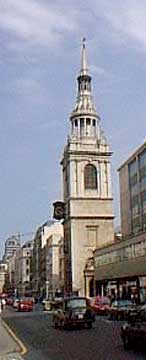|
|

St. Mary le Bow Cheapside, EC2
 The Church of St Mary le Bow was one of the first re-buildings erected by Sir Christopher Wren after the Great Fire of London in 1666. Its massive steeple, a square tower surmounted by four stories which reaches 235 feet into the sky, is a well-known landmark in the City, topped as it is by a weather vane in the shape of a sinuous golden dragon. The Church of St Mary le Bow was one of the first re-buildings erected by Sir Christopher Wren after the Great Fire of London in 1666. Its massive steeple, a square tower surmounted by four stories which reaches 235 feet into the sky, is a well-known landmark in the City, topped as it is by a weather vane in the shape of a sinuous golden dragon.
Wren's solid-looking structure was raised on the site of what was already a very ancient church. As far back as the reign of William the Conqueror, the church of St Mary was known as 'St Marie de Arcubus or Le Bow' because of its arches of stone. And so the name has come down to us to this day.
Perhaps one of the most famous features of St Mary le Bow is its bells. These are the bells that a poor runaway boy is said to have heard as he was resting on Highgate milestone when they called: 'Turn again, Whittington, Lord Mayor of London.' And popular folklore still maintains that only Londoners born within the sound of Bow Bells have the right to call themselves Cockneys.
An interesting historical feature of St Mary's is the balcony in front of the tower. This is a memorial to an incident in 1331 when a wooden balcony containing the Queen and her ladies fell during a tournament celebrating the birth of the Black Prince. The balcony continued to be used as a vantage point, despite this mishap, and the Henrys and Edwards came to watch all the great city pageants from here. After Wren rebuilt the church, Queen Anne saw the Lord Mayor's pageant from the balcony in 1702. It was the final display to be devised by the last official City poet.
Another and more famous poet to be associated with the church of St. Mary le Bow is John Milton, who was born in nearby Bread Street. A crumbling plaque on the exterior wall of the church commemorates this fact. As was common in those days, Milton frequently published his works from church yards in Fleet Street. The best-known of these, 'Paradise Lost' was published from St. Dunstan's, Fleet Street .
 This was the district where boot makers worked in goatskin leather. The leather was known as Cordovan and the workers as cordwainers. A statue of Captain John Smith (1580 - 1631) a cordwainer who rose to become Governor of Virginia and Admiral of New England, was therefore appropriately placed here outside the church This was the district where boot makers worked in goatskin leather. The leather was known as Cordovan and the workers as cordwainers. A statue of Captain John Smith (1580 - 1631) a cordwainer who rose to become Governor of Virginia and Admiral of New England, was therefore appropriately placed here outside the church

St. Mary-le-Bow is open every weekday from 6 am until 6 pm (4 pm on Fridays). No charge is made to view the main body of the church.
A reader has recommended the restaurant in the crypt.
 Bank or St. Paul's (Central line) Bank or St. Paul's (Central line)
Copyright © Jan Collie 2002
Published by permission of the author.
All rights reserved. No reproduction, copy or transmission of this publication may be made without written permission. |
|